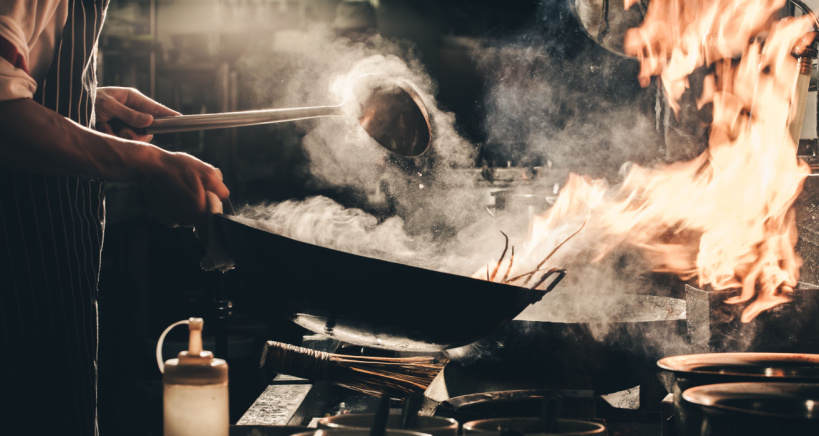 It’s 2024 and the world’s a village. Young Americans love to explore international cultures and flavors. Millions of young Americans listen to Korean-origin pop music (Kpop), consume Japanese-origin anime, learn Mandarin Chinese on Duolingo, and go out for Vietnamese cuisine. In the culinary world, global flavors and international cuisines are also trending, and diners look for exciting or novel flavors from other countries. Some of the most popular cuisines are from East Asia. A recent study found that Chinese, Thai, Korean, and Japanese were among the most Googled cuisines.
It’s 2024 and the world’s a village. Young Americans love to explore international cultures and flavors. Millions of young Americans listen to Korean-origin pop music (Kpop), consume Japanese-origin anime, learn Mandarin Chinese on Duolingo, and go out for Vietnamese cuisine. In the culinary world, global flavors and international cuisines are also trending, and diners look for exciting or novel flavors from other countries. Some of the most popular cuisines are from East Asia. A recent study found that Chinese, Thai, Korean, and Japanese were among the most Googled cuisines.
If your restaurant is looking to serve up dishes from East Asia, you need the proper equipment to make your Asian food dishes taste authentic and cook to perfection. Here, we will delve into some of the most popular flavors and the tools that are necessary to make Asian food, so you can start serving some popular global cuisines at your establishment.
The Ever Growing Appeal of Asian Flavors
A recent study found that Chinese food was the most Googled cuisine. Chinese restaurants in the United States are ubiquitous for their sweet and sour flavors, stir fries, tangy salads, tender meat, and fried rice. An interesting fact about Chinese flavors is that the Southeast Asian nation was the first to invent soy sauce, and the salty, umami condiment has maintained its position as a staple flavor in East Asian food, and has been adopted by Japanese and Korean culinary culture.
What’s in a Wok?
To make those famous Chinese, Japanese, and Korean stir fries, you will need to start with a wok. The word “wok” means “cooking pot” in Cantonese, but it’s really a cross between a pot and a pan. Chinese woks have a unique shape, sort of like a deep frying pan, but with a rounded bottom that makes it easier to stir the food and conduct the heat source.
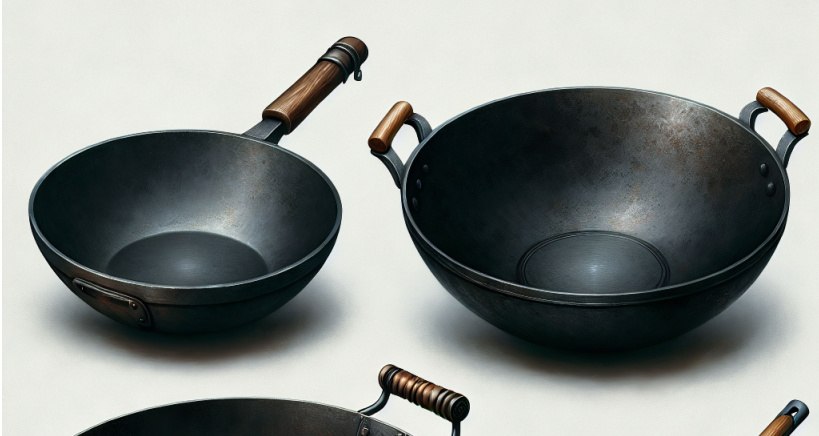
The wok owes its shape to its roots in the fuel-scarce Canton region of China, where it appeared about 2,000 years ago. Because feeding the flames wasn’t easy, the ancient Cantonese invented a cooking vessel that conducts heat well. They also used heated oils and chopped food to cook more efficiently and quickly, saving precious fuel. The rounded wok could be used to quickly prepare a number of dishes, like sauces, stir fries, roasted nuts and could be used just as effectively for braising, smoking, steaming, frying, searing, and preparing traditional foods like rice or dumplings.
Selecting a Wok
When it comes to selecting a wok, if you want that classic caramelized smoky flavor that Chinese refer to as “wok hei,” you’ll want a wok that is made from cast iron, heavy iron, or carbon steel. These materials heat up much faster and more evenly than stainless steel. Although cast iron is more traditional, carbon steel is more durable and longer lasting. Try to select a wok that is thick enough (more than one millimeter thick) so that it won’t warp during cooking.
There are two types of woks that you can typically find. The more common one is a flat bottomed wok with sloping sides. Although rounded-bottom Chinese woks are more traditional, flat bottomed woks fit on a typical stove top. The pro of these woks is that they integrate better into a modern kitchen. The con is that they don’t sear as evenly, or stir as readily as the rounded-bottom Chinese woks. Chefs who want to choose a rounded bottom wok will need a griddle or flat-topped grill and a wok ring to balance the circular dish on the heat surface. Another difference between traditional and modern woks is that the more common ones have one long handle for flipping and frying, whereas traditional Chinese woks have two short handles for lifting on and off the flames.
In addition to a wok ring, chefs cooking with a wok need another accessory. Spatula and ladle-like instruments with long handles are needed when frying with a wok. Since woks heat quickly, efficiently, and reach high temperatures, the chef will need something with a long handle to protect them from the heat. There are some utensils that are traditional for Asian cuisine, for example the Japanese-origin teppanyaki spatula, (which, due to its shape is suited more for flat-bottomed grills and pans) as well as bamboo and Asian spatulas.
Caring for Your Wok
A good wok can last for decades, but it needs to be cared for properly. A carbon steel wok should be sponged, not scrubbed, before being dried. After washing your wok, you should rub a little bit of oil into it. Over time, the oil will be melted into microscopic polymers giving the pan a naturally non-stick surface. This is called “seasoning the wok.” A seasoned wok will turn black over time, and that’s a good thing. Just make sure to dry the wok completely first, so it won’t get rusted, before seasoning it. And never put it in the dishwasher.
Even if you aren’t an Asian eatery, it can still be worthwhile to invest in a wok. The secret of a good wok is that it’s versatile and heats evenly. This makes it a good choice for deep frying on a range. It’s also a good pan for roasting, pan searing, making sauces, boiling, and stir frying.
Heating Your Wok
If you are going for the stir fried wok hei flavor, you will also need a range that can handle high heat. Look for something with a high BTU output that can heat your oil quickly and efficiently. You want a BTU above 10,000 BTUs. If you have a rounded wok, you can look for a dedicated wok range for professional wok cooking.
Another thing to keep in mind when wok cooking is that you will need an adequately ventilated space. Stir frying asian food produces delicious smells, but also lots of smoke, so you’ll want an adequate ventilation and extraction system.
Steamed Dumplings
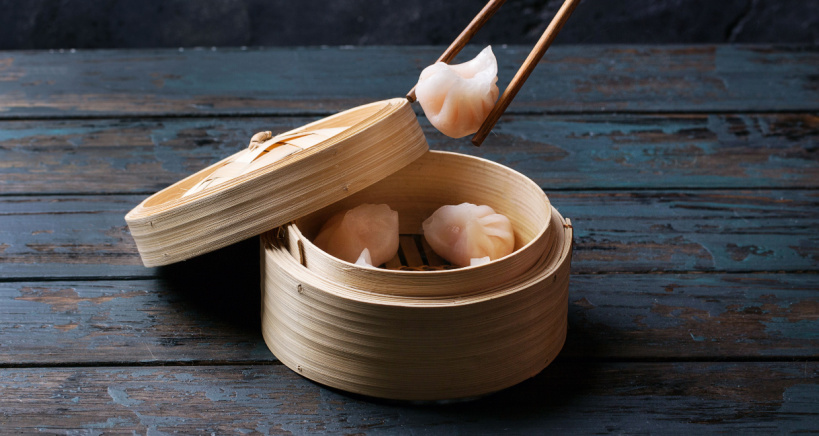
Another wok accessory is a bamboo steamer. The bamboo steaming method is even older than the wok, dating back approximately 5,000 years. Bamboo steamers are traditionally used to make dumplings and dim sum, but there’s a number of other Asian dishes that can be steamed in these little baskets, including duck, fish, tofu and a number of Thai dishes like sticky rice. You can even make eggs in a bamboo steamer.
Essentially a bamboo steamer is a basket, traditionally made from bamboo, although more modern ones use different materials, that is placed inside a wok filled with water. The water is heated, releasing steam that wafts through the basket perfectly steaming the dish inside. A pro-tip when it comes to steaming food is that you can stack the steamer to cook two different foods at the same time.
Rice Cooker
Stir fried and steamed food are two ubiquitous ingredients in East Asian cooking. Rice is another. This grain was domesticated in China around 10,000 years ago, and today China still holds the world record in rice production. Rice plays a big role in Chinese culture and cuisine as well as in a number of other Asian cultures. In fact the word “fan” can mean both rice and a meal. There are a number of varieties of rice. Thai and Chinese cuisine uses a short grain rice like Jasmine rice, whereas Vietnamese cooking typically uses a longer grain form of Jasmine. In Korean and Japanese culture, Japonica rice, which is sticky sushi rice, is fairly common.
A rice cooker can make the process of preparing rice easier and faster with the rice turning out more consistently done than by traditional cooking methods. Another benefit of rice cookers, which is important for any restaurant that serves rice based dishes throughout the day, is that this machine can keep the rice at a warm temperature without drying it out or needing to heat and reheat it. A good rice warmer can keep the cooked grain warm for more than ten hours. Rice cookers can also make the sticky rice needed for several Thai and Korean dishes.
A rice cooker can be a useful appliance even for a restaurant that rarely serves rice as it can double as a slow cooker and can be used to make oatmeal and stews. There are even a number of tasty desserts that can be made in a rice cooker.
Sushi Making
Chinese food might be the most searched cuisine, but Japanese food isn’t far behind. Sushi is one of Japan’s biggest contributions to the American restaurant scene and now this dish finds its way into a number of menus. Japanese restaurants typically offer sushi, but sometimes so do steakhouses, pizzerias, fish restaurants, and even Chinese establishments. You can even buy it in supermarkets, and find (less high quality versions) at gas stations and convenience stores.
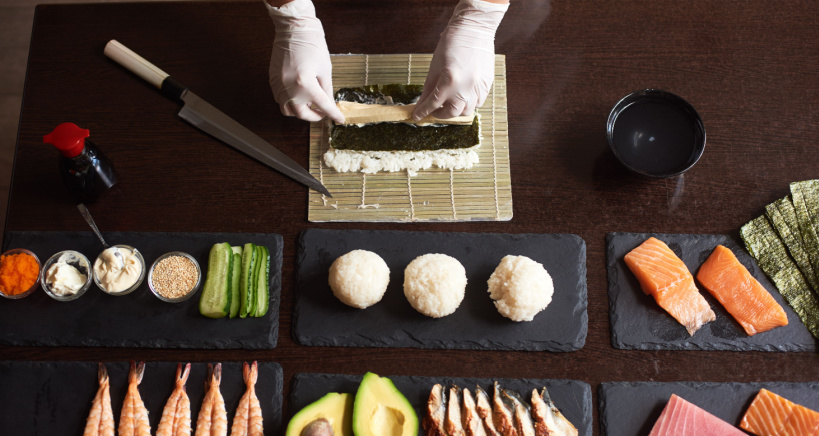
The most important component to making sushi is the sushi knife. The best sushi chefs will shell out hundreds of dollars for sharp, high-quality, handcrafted sushi knives. Sushi knives differ from other chef’s knives in a few ways. Firstly, they are made from a sharper high-carbon steel. They also have only one beveled edge. The flat, non-beveled side keeps the sticky sushi rice from adhering to the knife. Sushi knives are fixed blade knives that have a full tang or half tang. That means that the metal part of the handle, which is attached to the blade, runs all the way down the handle or halfway down it.
Sushi knives aren’t the only knife that Asia is famous for. To prepare the vegetables, meat, and other ingredients for a stir fry or a sauce, you need a high-quality chopping knife that can handle all types of food from textured meats, to soft tofu, to nuts, and vegetables. A Chinese cleaver is especially useful for preparing thick cuts of meat and quickly chopping, mincing, dicing, crushing all the other ingredients. Don’t forget that you will need a high-quality cutting board that can handle this weighty chopper.
Another piece of equipment crucial for making sushi is a bamboo mat. The sushi chef places the nori, rice, fish, and other ingredients layered on the mat and uses the mat to roll it into a tight sushi roll.
Fried Asian Delights
Speaking of sushi, tempura is a popular deep-fried sushi option, and in order to make tempura you will need a strainer or a skimmer. A strainer is also a must-have for other deep fried and boiled dishes. For example, to remove dumplings that are fried or boiled and to take meat and vegetables out of a hot pot, look for a metal skimmer, preferably with a long handle.
Asian Food Seasonings
East Asian cuisine is known for its bright, hot, and pungent spices. A popular spice blend in Chinese is the Five Spice mix, made from star anise, Sichuan peppercorns, cinnamon, fennel seeds, and cloves. Ginger is another common spice.
A mortar and pestle is a great tool to have for making fresh spice blends and grinding fresh spices. It can also be used in sauces and pastes. For example, Thai curry paste is a spicy, tart base for Thai curry, made with spices like chili, garlic, ginger, soy sauce, sugar, cumin, coriander, and pepper, blended with coconut milk and prepared with a blender, or by hand, with a mortar and pestle.
Korean Cuisine
Korean culture has never been more popular in the United States than it is today. Young Americans are consuming K-comics, listening to K-pop, watching K-drama and eating Korean foods. Kimchi, a Korean fermented cabbage condiment, exports from Korea to the United States nearly doubled from 2019 to 2022, both due to the increasing popularity of Korean culture and due to the popularity of fermented foods.
To make homemade Kimchi and other fermented products, it’s a good idea to invest in a kimchi refrigerator. A kimchi refrigerator is a special refrigerator designed around the needs of the kimchi fermentation process. It has a colder and more consistent temperature than a typical refrigerator and is more humid. Another option is to look for a separate fridge for fermentation, so you can adjust the temperature without having to worry about the rest of the foods inside.
Korean culture enthusiasts also like Korean barbecue, which is a special method of preparing meat on a tableside grill. It makes the dining experience more fun and interactive to see the meat prepared at the table itself. Some Korean restaurants have built-in grills attached to the tables, while others use portable stoves. KBBQ is usually marinated before it is grilled and served with side dishes and wrapped in a lettuce leaf. It’s tasty, savory, trendy, and fun.
Serving Asian Food
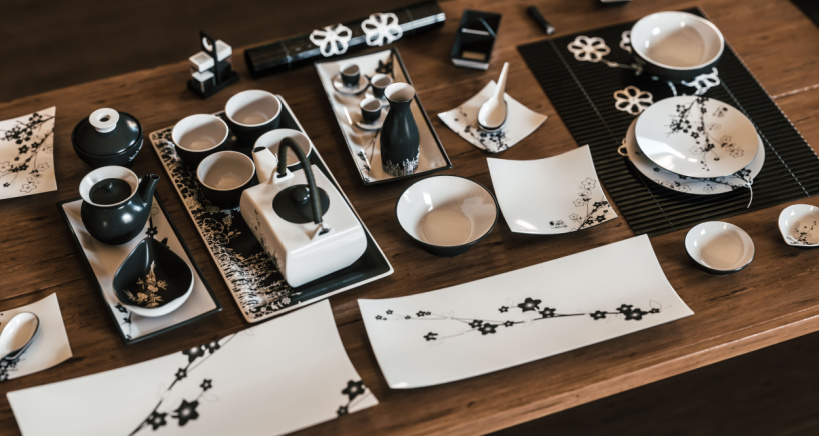
When it comes to offering Chinese, Japanese, Korean, Vietnamese, Thai and other Asian cuisine at a restaurant, cooking the dish is only half the work. Diners eat with their eyes as well, so it’s important to find attractive, culturally-appropriate serving dishes.
To serve Asian food, it’s important to have rice bowls for rice dishes and noodles, sushi platters for sushi, and sauce dishes to serve the myriad of tasty sweet, sour, spicy, and salty sauces that Asian food is known for. Of course, chopsticks are essential for eating solid foods, and for soups and liquid dishes, diners will need Asian spoons.
Last, but not least, when it comes to offering Asian foods at a restaurant, don’t leave out the beverages. Tea is important drink in several Asian cultures, so look for a traditional ceramic teapot and Chinese tea cup set.
As the popularity of Chinese, Japanese, Korean, and other Asian cuisines continues to soar, having the right equipment for your restaurant can be a beneficial investment. From the versatile wok, deeply rooted in ancient Chinese culinary traditions, to essentials like chopsticks and rice cookers, each piece plays a crucial role in bringing forth the authentic flavors of East Asia. Aspiring restaurateurs should pay homage to cultural nuances, source authentic ingredients, and select appropriate cooking and serving dishes. With the right equipment, passion, and attention to detail, your restaurant can become a haven for those seeking an immersive experience in the diverse and delectable world of East Asian cuisine.